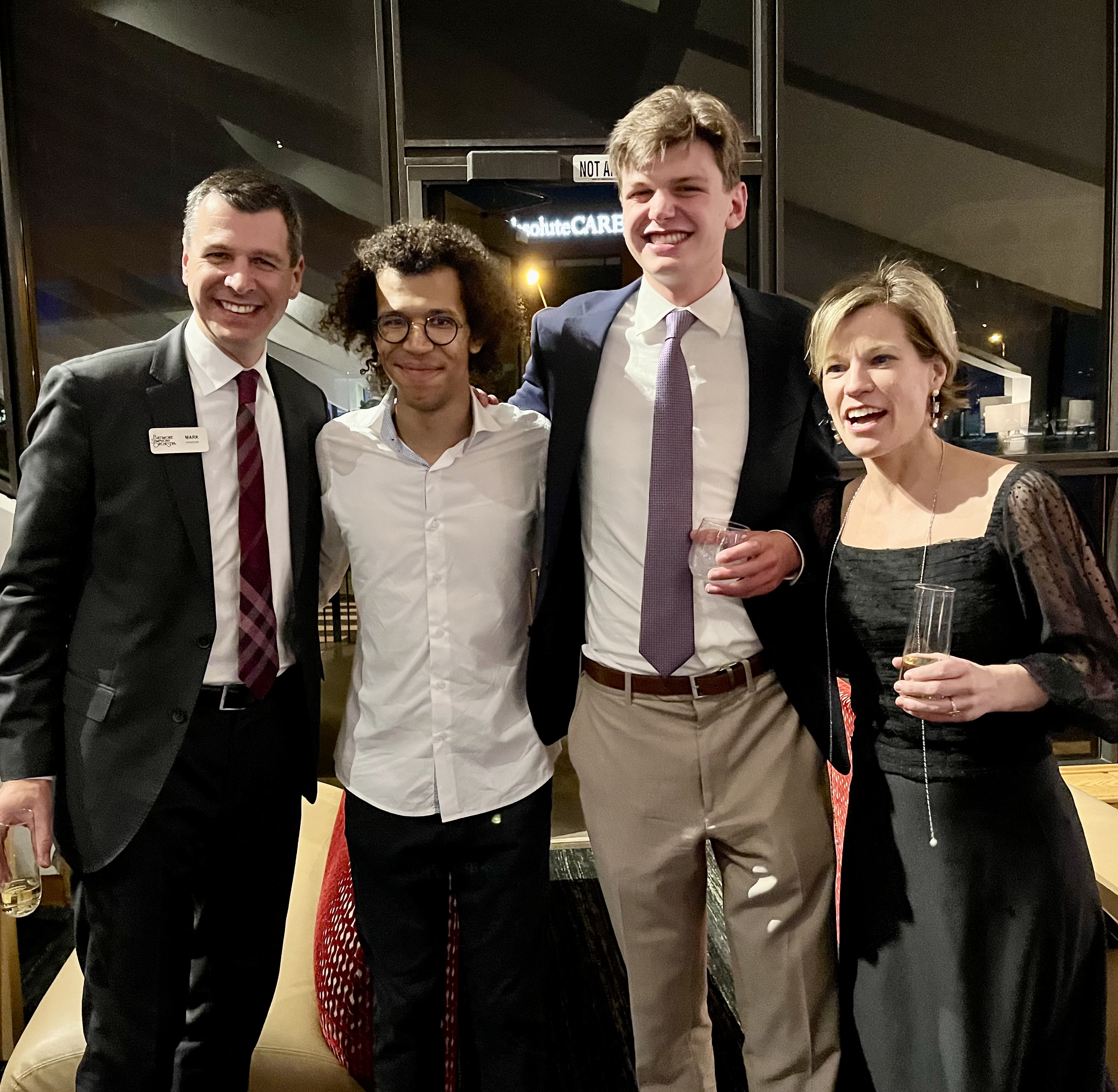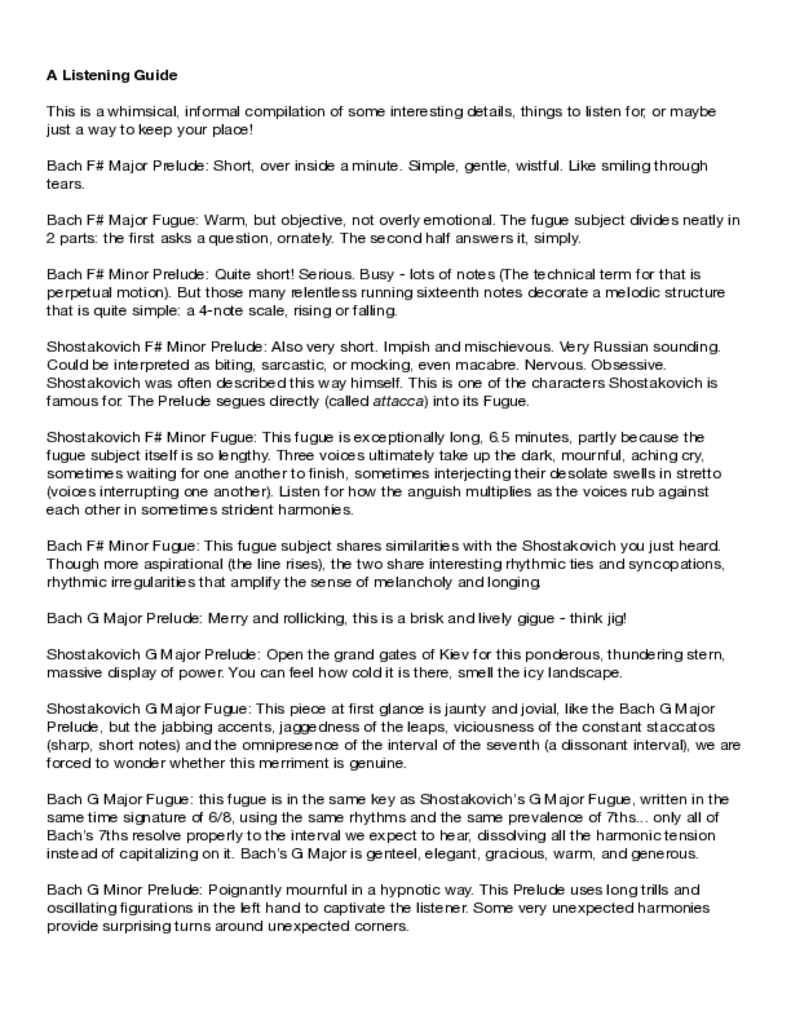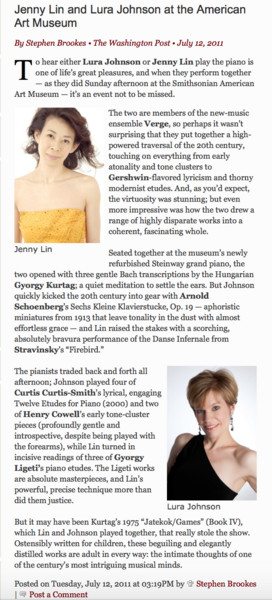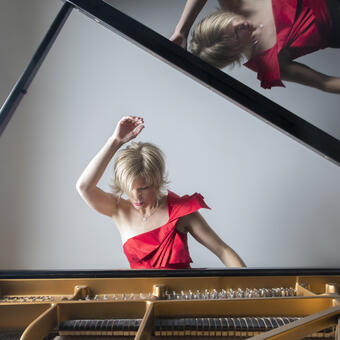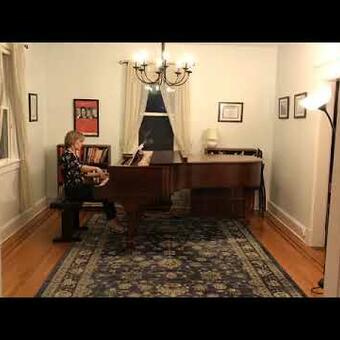Work samples
-
Lura Johnson plays Liebesfreud, by Kreisler, transcribed Rachmaninoff
Recorded at the Grand Opera House in Wilmington DE for its virtual gala in conjunction and partnership with the Delaware Symphony Orchestra. November 2020
-
124. Fugue in A Flat Major, BWV 886_0.wav
From Lura's mammoth solo project, The Art of Prelude and Fugue, being released by Azica Records on all digital platforms in February 2025. The Art of Prelude and Fugue, a mammoth and visionary solo project, is a first-of-its-kind curation of the entire Well-Tempered Clavier of J.S. Bach interspersed with the complete Preludes and Fugues of Dmitri Shostakovich, with an emphasis on the striking connections between the works.
About Lura

Steinway Artist Lura Johnson is celebrated for her insightful, emotionally impactful performances. The Washington Post describes hearing her play as “one of life’s great pleasures.” The Baltimore Sun praises her “surging expressive force... impressive bravura...” and “exceptional vitality, color, and impact.” Performing more than one hundred concerts annually as a soloist, chamber musician, and orchestral pianist, Lura captures, distills, and powerfully communicates the… more
A Unique Vision: Bringing Beauty and Healing to our Confused World
When I was a child, I declared it my mission to "make my piano teacher cry." It wasn't that I wanted to frustrate or aggravate her, but because I wanted her to be touched by the beauty and expressivity of my playing. Even as a young child, I felt a calling to help people connect with their feelings through the music I was playing.
In my mid-teens I attended a chamber music camp in the Massachusetts Berkshires called Greenwood, an idyllic place where we students ran barefoot all summer and played chamber music with our friends. Every Saturday night, we gave a concert for the community to attend. One Saturday night, my group and I gave a rousing performance of the first movement of Dvořák's Piano Quintet in A Major. My group and I played our hearts out, and as we were taking our bows and basking in that joyful energy that comes at the end of a good performance, we noticed that people in the audience were visibly moved. Some people were crying. I was astonished by what I was witnessing - the power of music to communicate with people and to awaken emotions in them. In that moment, I knew I wanted to spend my life being in the presence of this power - channeling it and sharing it with others. That was the night I dedicated my life to bringing beautiful music to people as a way of changing their lives, even if just for a few hours at a time, by providing the opportunity not only to enjoy beauty, but to connect with their emotions and their deeper selves at the same time.
It is my privilege now to spend my career creating a world of artistic beauty that represents something bigger than all of us.
Connecting Virtually - A Viral Response
In mid-March, the world stopped turning. Schools, workplaces, businesses, all were closed. Citizens were asked, in the name of public health, to help stop the rampant spread of the novel coronavirus by staying in their homes. It was shocking. Unthinkable.
At the end of my second day of quarantine, I'd already had the impulse: I had a phone. I had an internet connection. I could still play music for people! On Sunday, March 15, 2020, I did so in my first of more than three dozen livestreamed recitals.
From then through the middle of July, I performed a weekly recital every Wednesday evening at 8 pm. People everywhere were turning to art for solace in a frightening time. Artists everywhere were turning to people to continue sharing their work in whatever way they could. I do not pretend to be the only artist who began livestreaming concerts from my home during this time, but I do believe I was the first in the mid-Atlantic region to do so, and I became one of the most prolific. Audiences grew. People commented on how much they looked forward to Wednesdays, their favorite night of the week. I looked forward myself. During the pandemic, I sold my house. All the furniture was moved out. Audience members noted that week by week, the room I was playing in changed. Paintings were taken off the walls. Soon the rug was gone. While I was looking for a new home, I was undeterred in my quest to keep the music playing, for myself, and for my audience. I began broadcasting from the home of dear friends and so the recitals continued. I took some time off in June to move into my new home, and in December 2020 the weekly concerts began again, this time on Sunday nights, to continue through at least the end of February, 2021.
Below is a selection of some of the most memorable programs I performed. This is just a sampling of an extraordinary output I offered to the community in its time of dire need. Clearly, humans needed physical healing at that time, medical healing. But they were also anxious, frightened, stressed, and isolated from each other. This was one of the most dramatically literal times that my playing brought healing to the world around me.
-
BSO Offstage, Episode 8 - The Greatest Love Story in Classical MusicAired live on April 22, 2020
-
BSO Offstage, Episode 7 - The War of the RomanticsAired live on April 15, 2020
-
BSO Offstage, Episode 11 - Boogie Woogie, Ragtime, and the Influenza BluesAired live on May 13, 2020
-
BSO Offstage, Episode 10 - Best Loved Piano Melodies of All TimeAired live on May 6, 2020
-
BSO Offstage, Episode 12 - Les AdieuxAired live on May 20, 2020.
-
BSO Offstage, Episode 14, The ForestAired live on June 3, 2020
-
Sunday Nights at 7, Episode 1: Lura Johnson presents Once Upon a Time: a presentation of ballades.Aired live on Sunday, December 20, 2020
-
Lura Johnson presents Ringing in the New Year!Aired live on Sunday, Jan 3, 2021
-
Lura Johnson presents Sunday Nights at 7, Episode 4: HyggemusikThe Danish people are some of the happiest in the world. One of the reasons is their focus on creating and enjoying warm comfy coziness with friends and family at every possibility. They burn candles, curl up by fires, and sip hot beverages wearing thick wool socks. I've been reading about hygge recently and thought I'd create a program of classical piano music consistent with these qualities. So grab your fuzzy socks and a cup of something hot to enjoy some hyggemusik!
Macrocosm of the Symphony Orchestra: Collaboration with the BSO
Pianists who can grasp and master the particular challenges of orchestral piano playing are uncommon. Stellar soloists and even accomplished chamber musicians often have difficulty with the very unique ensemble skills that are required. Furthermore, everything an orchestral pianist plays is a solo, making the position a unique nexus point between finely honed ensemble skills and soloistic virtuosity.
Many pianists are unused to following a conductor's beat patterns, particularly when they can change so dramatically from one music director to the next.
Another challenge is the difference in sound production between the piano and the other instruments in the orchestra - the piano produces immediate and instantaneous sound, while wind and string instruments have more cushion and delay to the beginning of their sound, as the breath or the bow connect with the air column or string. These differences in sound production result in necessary adjustments on the part of the orchestral pianist, so as to play in perfect synchronicity with the ensemble.
Another issue is distance: since light travels faster than sound, and the piano is normally placed physically in the back of the orchestra, playing directly with the beat one sees can cause a pianist to sound ahead of the other instruments. All of these issues combine to create a musical puzzle that is always different and always has a different solution.
Furthermore, pianists do not train for these challenges. Since any given orchestra generally has need for only one pianist, most don’t even consider orchestral playing in the constellation of activities they might pursue as a professional musician. I was fortunate to discover, about ten years ago, that I have a particular knack for this kind of adaptive, flexible, connective playing. Marin Alsop's first day on the job at the Baltimore Symphony Orchestra was my first as well. The challenge has been remarkably rewarding.
***
Ms. Johnson is the Resident Pianist of the Baltimore Symphony. She has been performing with the ensemble regularly since September 2007, when she played her first concert with the symphony under the baton of Maestra Marin Alsop. She continues on in her position now, as the BSO navigates its second season under new Music Director Jonathon Heyward. She has performed concertos with the orchestra (Bach's Brandenburg V and Saint-Saens Carnival of the Animals multiple times, and Gershwin's Rhapsody in Blue), collaborated extensively in orchestral performances with Yo Yo Ma, Itzhak Perlman, Midori, Leila Josefowicz, Joshua Bell, and Jean-Yves Thibaudet, Pinchas Zukerman, the St. Lawrence String Quartet and has performed with the orchestra on 5 commercial recordings released by the symphony:
1. Leonard Bernstein's Mass, which was nominated for a Grammy award. Ms. Johnson played principal keyboard and organ on this recording. Released 2009, Naxos label.
2. Mark O'Connor's Americana Symphony. Released 2008 on O'Connor's private label.
3. Jean-Yves Thibaudet plays Gershwin Concertos with the Baltimore Symphony. Ms. Johnson played orchestra piano in the Concerto in F. Released April 2010, Decca label.
4. Bartok, Music for Strings, Percussion, and Celesta. Released 2012, Naxos label.
5. Bernstein Symphonies #1 and 2. Ms. Johnson played piano on Symphony No. 1. Released 2016, Naxos label.
-
 with incoming Music Director Jonathon Heyward, BSO
with incoming Music Director Jonathon Heyward, BSO -
Lura with Baltimore Symphony Orchestra's Music Director Laureate, Maestra Marin Alsop
-
Bernstein: Mass - Confession_ EasyBaltimore Symphony, Marin Alsop conducting
-
Bernstein: Mass - Confession - I Don't KnowBaltimore Symphony Orchestra, Marin Alsop conducting
-
Bernstein: Mass - Credo - I Believe In GodBaltimore Symphony Orchestra, Marin Alsop conducting
-
Bernstein: Mass - Meditation #1Baltimore Symphony Orchestra, Marin Alsop conducting
-
Bartók: Music for Strings Percussion and Celeste, II. AllegroBaltimore Symphony Orchestra, Marin Alsop conducting
-
Bartok: Music for Strings Percussion and Celeste, IV. Allegro moltoBaltimore Symphony Orchestra, Marin Alsop conducting
-
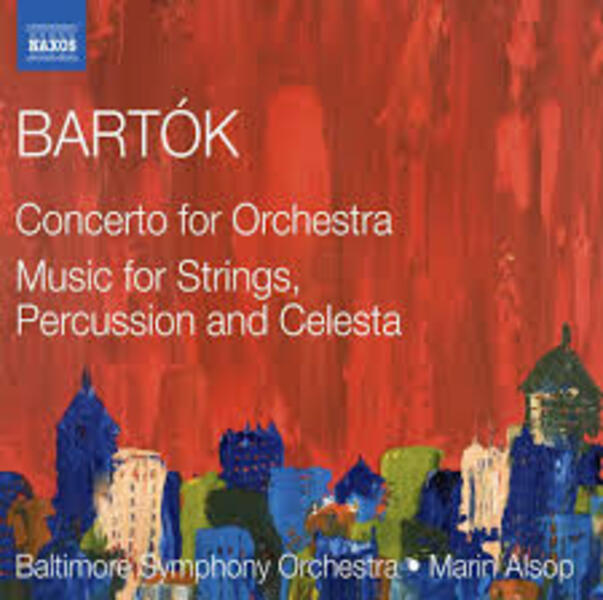 BSO plays Bartok CD Cover
BSO plays Bartok CD Cover -
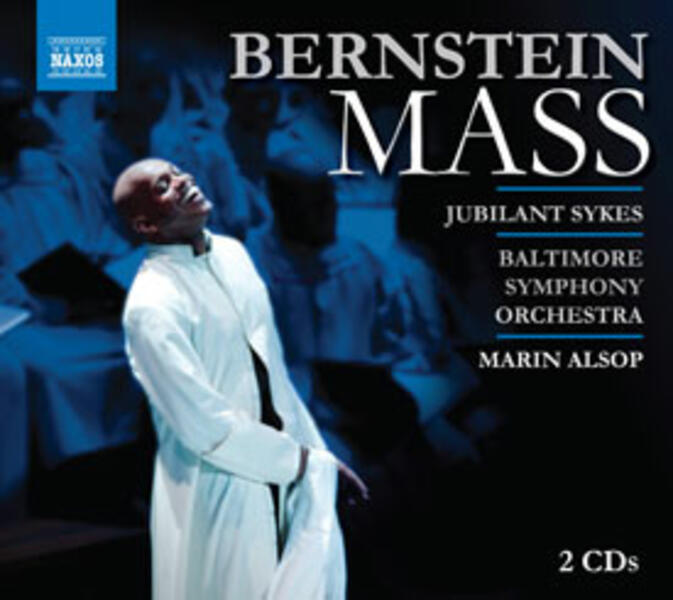 BSO Plays Bernstein Mass CD Cover
BSO Plays Bernstein Mass CD Cover
Connection of Two Musicians, Centuries and Cultures Apart - One Truth: The Art of Prelude & Fugue
The Art of Prelude and Fugue began as an idea prompted by a conversation I had with a student and few into a journey that has inspired, challenged, and changed me. The music of these two composers, J.S. Bach and Dmitri Shostakovich, is highly complicated, deeply contemplative, precise and exacting in an almost scientific way, and rigorously structured. Yet ultimately it transcends boundaries, transporting us to a realm of the most spiritual kind. While challenging our intellect to comprehend its stunning complexity, the music offers us, paradoxically, a place of stillness, serenity, and deep reflection. It is not just beautiful. It is significant, contributing to our cultural fabric and illuminating our humanity.
Historical context
In 1722, celebrated Baroque composer Johann Sebastian Bach wrote a set of contrapuntal exercises called preludes and fugues, one in each major and minor key of the twelve-step chromatic scale. This systematic series of intellectual and technical keyboard exercises (known as The Well-Tempered Clavier) was intended “for the profit and use of musical youth desirous of learning, and especially for the pastime of those already skilled in this study.” Some twenty years later Bach composed a second book of the same kind; together, the two represent some of the most important literature in the Western musical tradition. The 19th century conductor Hans von Bülow called it “the Old Testament” of piano music; Robert Schumann described it as “daily bread.”
On the 200th anniversary of Bach’s death in 1950, the first competition in his honor was held and Russian composer Dmitri Shostakovich was invited to serve as president of the jury. All the competitors at the Bach competition were required to present a prelude and fugue from Bach’s Well-Tempered Clavier; Shostakovich was therefore saturated in these works. Shortly after his return to St. Petersburg he wrote his own set of preludes and fugues, in direct response to the immersive exposure to the Bach compositions he had just experienced.
One of the most remarkable aspects of Bach’s keyboard music is the dearth of extramusical instruction. He offers next to no indications of tempo, dynamics, or articulation. Rather than being prescriptive, Bach gives us a blank canvas. The performer is an interpreter responsible for huge amounts of the musical decision making, yielding personal and individualistic performances that vary immensely from one artist to the next. The music emerges from any interpretation unassaulted and unblemished; it is so well written that it transcends any one performer’s voice. Shostakovich famously said, “A prelude or fugue of Bach can be played at any tempo, with or without rhythmic nuances, and it will still be great music. That's how music should be written, so that no-one, no matter how philistine, can ruin it.”
Though Shostakovich provides significantly more instruction to the performer than Bach does, he, too, leaves much to the performer. His music finds a similar potency through complexity masked as simplicity. Both composers rely almost entirely on counterpoint – linear, polyphonic music - to carry the weight of their message.
On the curation
The curated and interstitial nature of this recording is both shockingly unorthodox and yet a most natural format; the organization of the pieces is both daring and obvious. The weaving of the two works into one fabric reveals the interconnectedness of the two works and illuminates Shostakovich’s debt to the Well-Tempered Clavier for his inspiration.
My goal was to place side by side the compositions of Shostakovich with their antecedent, their direct inspiration. In some cases, the relationship I found is motivic, in other cases based more on mood and character, and in some instances centered around tonal key relationships.
The opening four tracks of this recording demonstrate motivic relationship as well as tonal connection: the trebly-voiced C Major arpeggio that opens the famous Bach C Major Prelude, BWV 846, is mirrored, identical in registration and in voicing, to Shostakovich’s C Major Prelude, Op. 87, No. 1. The chord is no longer arpeggiated, but is played as a simultaneity in a rhythm that evokes the Baroque dance, the sarabande.
The C Minor Prelude and Fugue of Shostakovich, Op. 87, No. 20, share a foundational motive that has its roots in the fugue subject of Bach’s Fugue in C Sharp minor, BWV 849. This creates an awkward key relationship between the works, but it makes clear Shostakovich’s inspiration. Many more such connections emerged for me, producing pairings sometimes surprising, always riveting.
I felt compelled on multiple occasions to separate a Bach prelude from its fugue, in order to highlight the striking allusions I was discovering. This seemed heretical or blasphemic to me, until I learned that many of the Bach preludes and fugues were not actually written as a pair, but were assembled as one retrospectively. Shostakovich’s preludes and fugues, on the other hand, were written not only as pairs, but each also flows attacca (uninterrupted) from prelude to fugue, making them inseparable from a curation standpoint. This meant that if I wanted to present two fugues adjacent to one another, the Bach pieces had to be separated, and the Shostakovich pieces dropped as an intact unit in between.
A spectacular example of this is Bach’s Fugue in E Major, BWV 878, which I paired with Shostakovich’s Fugue in F Sharp Major, Op. 87, No. 13. These fugue subjects share a narrow range of only a fourth, almost identical contour (a gentle arc), identical intervallic content, similarly slow-moving note values, and an unmistakable vocal quality, not to mention an atmosphere of sacred meditation. The only way to get them next to one another in the curation was to separate Bach’s pieces and drop the Shostakovich pair in between. I share many more examples of what went into my curational decisions in the Listening Guide that appears later in this booklet.
Many pianists have performed and recorded the complete Well-Tempered Clavier of Bach. An armful have performed and recorded the entire opus of Shostakovich’s Preludes and Fugues, Op. 87. A few have built concert programs using excerpts from both works.
But this recording represents the first curated compilation of the two works side by side, and it is certainly the only one to use the act of curation to make bold statements about the works themselves.
Phase One of this project was the live performance of the entire curation; I presented more than eight hours of music in a series of four concerts that took place at Baltimore's Peabody Institute of Music during the 2018-19 season. The forty-eight Bach Preludes and Fugues I performed in order. Shostakovich’s twenty-four I interspersed throughout where homage is present, even obvious. Response to these concerts was huge; audiences were transfixed. One listener wrote, "The programming here is fabulous, but the success of the concerts is also due to Ms. Johnson's bravery at the keyboard... Ms. Johnson looks to present each prelude and fugue with an individual sonic and emotional spirit... a disciplined performer, she somehow manages to exude both emotion and reserve simultaneously."
Documentary filmmakers Scott Meyers and Ali Walton created a video portrait dedicated to my work as an artist and to this project in particular which is included in this portfolio.
Phase Two included a series of residencies at music schools and departments around the country. These residencies included recitals with accompanying lectures, masterclasses, and clinics. Rice University's Shepherd School of Music hosted the first residency in Fall 2019.
Phase Three has been the recording of the entire project for commercial release. Lura spent 41 hours in the recording studio between November 2021 and and March 2022 to produce a high quality recording that will be released during the 2024 calendar year. The entire curation will be released digitally on all platforms, with a a limited edition “Best Of” two-disc box set showcasing highlights. Bonus materials will include program notes for historical context and a listening guide designed to illuminate the creative process. One audience member described the listening guide as "profoundly illuminating... I've never been to another concert in which a musician makes their thought process available to the audience, and I noticed a real difference in my ability to engage with the music on an intellectual level." (Example attached.)
-
TRAILER: Lura Johnson - The Art of Prelude and FugueProduced and created by videographers Scott Meyers and Ali Walton. Audio engineering by Bob Novak. Studio space provided by Red Bridge Studios. Creative direction by David Williams. In preparation for the project The Art of Prelude and Fugue, a four-concert cycle of concerts presenting the entire Well-Tempered Clavier of J.S. Bach, with the complete Preludes and Fugues of Dmitry Shostakovich curated by the artist and interstitially placed throughout. Repertoire performed in this video: J.S. Bach Prelude in C Major, from Well-Tempered Clavier, Book I J.S. Bach Prelude and Fugue in E Major, from Well-Tempered Clavier, Book II Dmitri Shostakovich Dance #1 from Three Fantastic Dances, Op. 5
-
Photography and Design by Scott Meyers.
-
How to REALLY learn a fugueLura Johnson, piano Home studio recording. December 2017 In preparation for the project The Art of Prelude and Fugue, a four concert cycle of concerts presenting the entire Well-Tempered Clavier of J.S. Bach, with the complete Preludes and Fugues of Dmitry Shostakovich interstitially placed throughout.
Connection to Self: A Solo Album
***
Turning is a collection of variation sets. This recording includes three works representing the genre of theme and variations in the traditional sense: Mozart’s Twelve Variations on “Ah, vous dirai-je Maman,” K. 265; Clara Schumann’s Variations on a Theme by Robert Schumann, Op. 20; and Derek Bermel’s masterpiece, Turning, written in 1995. The inclusion of the other two works casts a wider net on the concept of theme and variations: the Rachmaninoff work is a transcription of a solo violin piece, and Brahms’s set of piano pieces was composed using a technique called developing variation. As a collection, these five works represent the concept of variation from many different angles.
Recorded May 23-25, 2012 at Morgan State University’s Gilliam Concert Hall, Baltimore, Maryland.
Produced and engineered by Antonino d’Urzo, Opusrite Audio Productions.
Piano: Steinway, Model B, built 1916.
Piano Technician: Tom Wright, Wright Piano Services.
Cover Photo: Katya Chilingiri.
Booklet Design: Alexa Brooks.
-
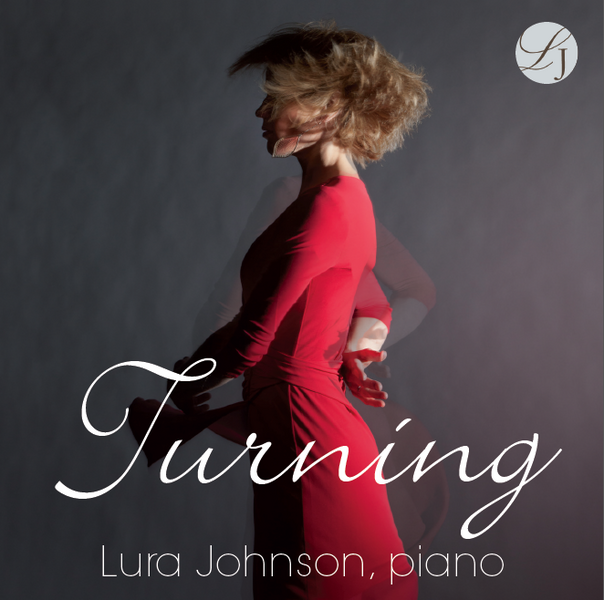 TurningKatya Chilingiri, photo credit.
TurningKatya Chilingiri, photo credit. -
J.S. Bach/S. Rachmaninoff: Violin Partita No. 3 In E Major, BWV 1006 - Preludio
-
J.S. Bach/S. Rachmaninoff: Violin Partita No. 3 In E Major, BWV 1006 - Gavotte.mp3
-
J.S. Bach/S. Rachmaninoff: Violin Partita No. 3 In E Major, BWV 1006 - Gigue
-
J. Brahms: Klavierstücke, Op. 118 No. 1, Intermezzo
-
J. Brahms: Klavierstücke, Op. 118 No. 2, Intermezzo
-
J. Brahms: Klavierstücke, Op. 118 No. 3 - Ballade
-
J. Brahms: Klavierstücke, Op. 118 No. 4, Intermezzo
-
J. Brahms: Klavierstücke, Op. 118 No. 5, Romanze
-
J. Brahms: Klavierstücke, Op. 118 No. 6, Intermezzo
Connection of Music and Narrative: Music for Film
1. Official teaser trailer, Gravity (2013), directed by Alfonso Cuarón, starring George Clooney and Sandra Bullock. Music selection: Arvo Pärt's spiegel im spiegel, taken from commercially released recording, Inner Voice, with Lura Johnson, piano and Peter Minkler, viola.
2. Ice Age: Collision Course Official Trailer #2 (2016) - Ray Romano, John Leguizamo Animated Movie HD. Music selection: Arvo Pärt's spiegel im spiegel, taken from commercially released recording, Inner Voice, with Lura Johnson, piano and Peter Minkler, viola.
-
Gravity - Official Teaser Trailer [HD]Music Credit: Arvo Pärt's spiegel im spiegel, performed by Lura Johnson, piano and Peter Minkler, viola, taken from their commercially released recording Inner Voice.
-
Ice Age: Collision Course Official Trailer #2 (2016) - Ray Romano, John Leguizamo Animated Movie HDMusic Credit: Arvo Pärt's spiegel im spiegel, performed by Lura Johnson, piano and Peter Minkler, viola, taken from their commercially released recording Inner Voice.
Connection to Place: Inspiration of Homeland
Nine years later, I discovered that there existed a competition for the thing I love most in life, the chamber music of Brahms. The contest is held in Pörtschach am Wörthersee, a tiny berg nestled amidst the Austrian Alps, where Brahms spent the summers of 1887-1889. There he wrote some of that very music that has grown so important to me. I immediately contacted one of the chamber music partners with whom I have the strongest sense of musical connection: cellist Ilya Finkelshteyn had been the principal cellist of the Baltimore Symphony from 2002-2009, during which time we had played together extensively and with great joy. Ilya agreed that going to Austria to compete in the International Johannes Brahms Competition's Chamber Music divison was something that we should do. We applied, were accepted, and began working in earnest on our program, which included both Cello Sonatas by Brahms, in addition to works by Schumann, Bolcom, Beethoven, Debussy, and Piazzolla.
We arrived in Pörtschach on September 4, 2015. From then until we departed on September 14 we were completely immersed in the music of Brahms. We spent every day focused on musical ideas concerning phrasing, color, articulation, and structure, diverted only momentarily by needs for food, drink, and sleep. We won the Second Prize, and the experience was life changing for me, in that I now seek that experience of depth and concentrated engagement whenever possible. I have now returned to the Brahms competition four times since then: in September of 2016, 2017, and 2018 I was official pianist for the competition, playing chamber music in the semi-final round of the cello division; in 2019 I served as a member of the jury in the Piano Competition. My travels in Austria in 2017 included two solo piano recitals, one in Vienna and one in Salzburg, where I performed all-Mozart programs in cathedrals that dated from the 900's A.D.
I am surprised by how much my connection to the classical music of Austria has been augmented by spending time in there. I have always loved the music of Austrian composers Mozart, Brahms, Schubert, Bruckner, Haydn, Mahler, and many others. But to see the natural beauty they saw, to walk through the homes where they lived, and to breathe the air they breathed has changed my relationship to the music in a vivid way.
***
Cellist Ilya Finkelshteyn and pianist Lura Johnson have maintained an active chamber music partnership since 2004. In September 2015, as Duo Baltinati, they traveled to Pörtschach am Wörthersee, Austria, to compete in the 22nd annual International Johannes Brahms Competition, where they were awarded the Second Prize in the chamber music division. The duo was one of 32 ensembles and 77 artists. Their program included Schumann Fantasiestücke, Bolcom Capriccio, both Brahms Cello Sonatas, Beethoven C Major Cello Sonata, Debussy Cello Sonata, and Piazzolla’s Le Grand Tango. The following recordings were taken from a live performance the duo gave in Baltimore in January, 2006.
-
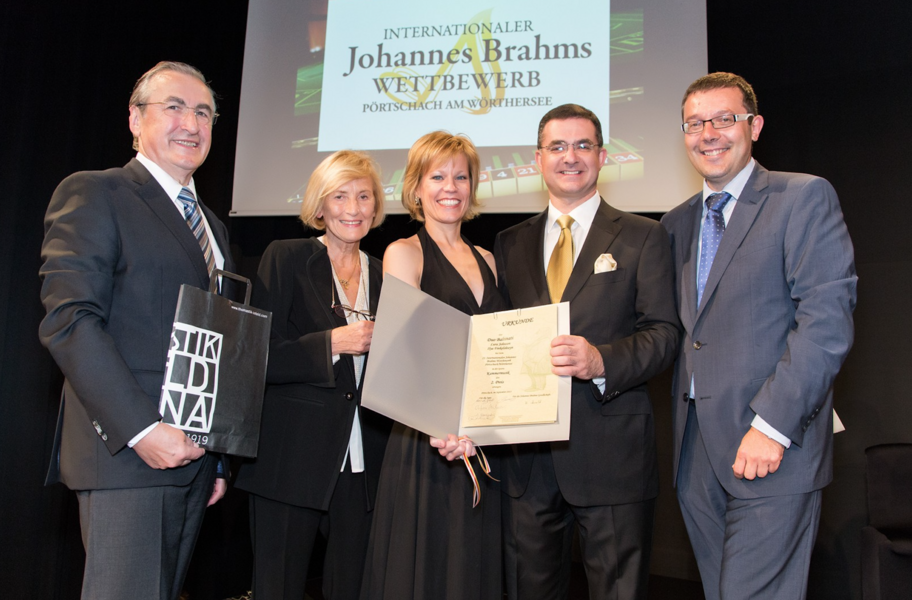 Duo BaltinatiReceiving the 2nd Prize in Chamber Music at the 22nd International Johannes Brahms Competition in Pörtschach, Austria, September 2015.
Duo BaltinatiReceiving the 2nd Prize in Chamber Music at the 22nd International Johannes Brahms Competition in Pörtschach, Austria, September 2015. -
Robert Schumann - Fantasiestücke, Op. 73, I. Zart und mit AusdruckDuo Baltinati, Ilya Finkelshteyn, cello and Lura Johnson, piano Live Performance
-
Robert Schumann - Fantasiestücke, Op. 73, II. Lebhaft leichtDuo Baltinati, Ilya Finkelshteyn, cello and Lura Johnson, piano Live Performance
-
Robert Schumann - Fantasiestücke, Op. 73, III. Rasch und mit FeuerDuo Baltinati, Ilya Finkelshteyn, cello and Lura Johnson, piano Live Performance
-
Pörtschach am Wörthersee, AustriaThe train ride from Salzburg to Pörtschach. Herr Brahms himself wrote of this place, in a letter to his friend Eduard Hanslick, "So many melodies fly about one must be careful not to tread on them."
-
Lake Wörthersee
-
Sunset on Lake Wörthersee
-
The house in which Brahms summered, 1887-1889This house, tragically, was torn down by a real estate developer in the late fall of 2015. It is now an apartment building.
Ultimate Connection Through Musical Conversation: Chamber Music
***
Ms. Johnson has had an affinity for chamber music from a young age. The partnerships she finds most fulfilling are those which generate an atmosphere of discipline during the rehearsal process and spontaneous creation and innovation in performance. Her penchant for communication with her instrument, the composer, her fellow musicians, and her audience has found fulfillment in her duo with violinist Netanel Draiblate. Times Two Duo concertizes regularly together and released a recording, Perspectives, in 2013.
-
 CD Cover, PerspectivesKatya Chilingiri, photo credit.
CD Cover, PerspectivesKatya Chilingiri, photo credit. -
Sir Edward Elgar - Salut d'amour, Op. 12, "Liebesgruss" (version for violin and piano)From commercially released recording, Perspectives, with Netanel Draiblate, violin.
-
Edvard Grieg - Violin Sonata No. 1 in F Major, Op. 8: I. Allegro con brioFrom commercially released recording, Perspectives, with Netanel Draiblate, violin.
-
Edward Grieg - Violin Sonata No. 1 in F Major, Op. 8: II. Allegretto quasi andantinoFrom commercially released recording, Perspectives, with Netanel Draiblate, violin.
-
Edvard Grieg - Violin Sonata No. 1 in F Major, Op. 8: III. Allegro molto vivaceFrom commercially released recording, Perspectives, with Netanel Draiblate, violin.
-
Felix Mendelssohn - Violin Sonata in F Major, MWV Q26: I. Allegro vivaceFrom commercially released recording, Perspectives, with Netanel Draiblate, violin.
-
Felix Mendelssohn - Violin Sonata in F Major, MWV Q26: II. AdagioFrom commercially released recording, Perspectives, with Netanel Draiblate, violin.
-
Felix Mendelssohn - Violin Sonata in F Major, MWV Q26: III. Assai vivaceFrom commercially released recording, Perspectives, with Netanel Draiblate, violin.
-
Fritz Kreisler - La GitanaFrom commercially released recording, Perspectives, with violinist Netanel Draiblate.
Connection to Present: Music by Living Composers
Classical music hallows its past. We cherish our heritage, revere the great composers who founded and fostered our tradition, and consequently create the impression that we function as a museum that presents only old works by composers who have been gone from us for hundreds of years. In fact, classical music is alive and teeming with exciting music that represents our time. This music of now has diverged quite far, in many cases, from the style of the old beloved masters, and for some performers it lies outside their comfort zone. Since my early teens when I was first exposed to freshly composed works, I have been attracted to and comfortable in this medium. Rather than connecting with a text, the performance of new music offers a performer the opportunity to connect directly with its author, to receive suggestions and feedback straight from the horse's mouth, to learn the composer's intentions from the source. How many times do musicians long for the opportunity to ask Beethoven a question about tempo, or Bach a question about articulation? In the world of new music, all such questions can be answered.
My work as a performer of new music connects me not just to individual composers but to the musical and artistic landscape of my society as an integral and vibrant member of its arts community.
***
Ms. Johnson has performed, commissioned, and recorded new music for the 17 years, as a member of the Towson New Music Ensemble, in residence at Towson University, and Verge Ensemble, the oldest running contemporary music group in Washington D.C. She has collaborated on five recordings featuring contemporary classical music compositions:
1. Premiering Greg Bullen’s Piano Concerto, The Water is Wide, with the Adesso Chamber Orchestra, BMA, 2023.
2. Premiering Greg Bullen’s Violin Sonata at the BMA in 2023 with Netanel Draiblate.
3. Complete Flute Music of George Rochberg, released in March 2015 on American Classics (Ms. Johnson performed Rochberg's Between Two Worlds, for flute and piano with Christina Jennings, flute)
4. Music of Jeffrey Mumford, released in January 2014 on Albany Records (Ms. Johnson commissioned and performed Mumford's evolving romance for flute and piano with Christina Jennings, flute)
5. New Paths: Music of composer Lawrence Moss, released in November 2011 on Innova Recordings (Ms. Johnson performed the song cycle From the Chinese with soprano Kathryn Hearden)
6. Mark O'Connor's American Symphony, self-released in 2008 by Mark O'Connor (Ms. Johnson performed with the Baltimore Symphony Orchestra under the baton of Maestra Marin Alsop)
7. Night Music by Karen Amrhein, self-released in 2008 by Karen Amrhein (Ms. Johnson performed Amrhein's solo set Dance Card)
-
Premiere, Greg Bullen Piano Concerto, May 2023
-
Greg Bullen Violin Sonata, with Netanel Draiblate, violin
Live premiere at the Baltimore, Museum of Art, May 2023.
-
Jeffrey Mumford - An evolving romance for flute and pianoCo-commissioned by Lura Johnson and Matthew Horwitz-Lee in 2005, included on commercially released recording The Jennings-Johnson Duo, with Christina Jennings, flute - and rereleased on Albany Records on commercially released recording Through a stillness brightening.
-
Lawrence Moss - From the Chinese: Cloth of GoldKathryn Hearden, soprano and Lura Johnson, piano from their commercially released recording New Paths
-
Lawrence Moss - From the Chinese: Crossing Han RiverKathryn Hearden, soprano and Lura Johnson, piano from their commercially released recording New Paths
-
Lawrence Moss - From the Chinese: Dao de JingKathryn Hearden, soprano and Lura Johnson, piano from their commercially released recording New Paths
-
Lawrence Moss - From the Chinese: RiceKathryn Hearden, soprano and Lura Johnson, piano from their commercially released recording New Paths
-
A.J. McCaffrey - Reflections on Beati quorum via (2003)From commercially released recording, The Jennings-Johnson Duo, with Christina Jennings, flute.
-
Karen Amrhein - Dance Card: Mister Charleston ButlerFrom a commercially released recording, For Moonlight: Night Music..." of the works of Karen Amrhein.
-
Karen Amrhein - Dance Card: Rumba in FivesFrom a commercially released recording, For Moonlight: Night Music..." of the works of Karen Amrhein.
Mastery of Craft: Reviews and Testamonials
One way to evaluate the degree to which a person has attained mastery of their craft is through feedback from independent third parties. I include here articles and quotes from various newspapers, magazines, and online sources. Additionally, I provide testimonials from performers, composers, and former teachers.
REVIEWS
“[Delaware Symphony Orchestra] principal pianist Lura Johnson rendered the first movement with an air of confidence and ease — her cadenza powerful yet insightful and moving… her virtuosity sizzles.” (Christine Facciolo, Delaware Arts Info)
“Johnson’s piano work was spot-on, with a lovely cadenza and flawless timing… a jaw-dropping flurry of flying fingers…” (Steve Siegel, The Morning Call)
“an unusally well-structured performance that goes beyond superficial tonal beauties to reveal the score’s constitutive elements… [George Rochberg’s] sonata’s slow movement plumbs great emotional depths that are uncompromisingly conveyed by both musicians. Shostakovich’s Sonata… receives a restrained performance that lets the music speak its nihilistic message without rubbing it in with superimposed emotional antics. Minkler and pianist Lura Johnson make a marvellous team…” (Carlos Maria Solare, The Strad)
“Johnson’s riveting account of Prokofiev’s “Sonata No. 7, Op. 83,” though, really stole the show. It’s a complex, subversive work, written in 1942 after the arrest and subsequent death of a friend of the composer’s, and Johnson looked unflinchingly into its anguished depths… Johnson and Andrist gave it [Rite of Spring] a thundering performance, capturing the Rite’s jagged rhythms and driving, elemental power, and by the end you half expected the piano to be in pieces on the floor.” (Stephen Brookes, The Washington Post) (entire article here)
“Johnson flowed effortlessly and eloquently through Ives’s myriad unfolding moods and ideas with confidence and thoughtfulness, not losing their literary statement.” (The Washington Post)
“spirited … charming” (The New York Sun)
“Lura Johnson — the beautiful, model-thin guest pianist — played the Grieg Concerto in A minor, opus 16 with great flourish and technical prowess – hands flying in the air dramatically at the end of phrases and grabbing the piano with her left hand when she played with the right. The pyrotechnics, melodic control and technical prowess which won her the audition for the Delaware Symphony Orchestra were evident in her rendition of the cadenza in the first movement. In the second movement, she played softly and lyrically, trading off the melody with the oboe. The third movement was the most impressive in expression and melodic control. Her ability to bring out the melody over a soft slew of notes in the left hand in the third movement won me over.” (The Newark Post)
“…The duo’s dedication to this 1982 work [Rochberg, Between Two Worlds] proved true and palpable as they negotiated deftly through its atmospheric sonorities and thorny dissonances… ” “…It was Johnson’s dynamic and confident playing that drove this piece [Franck A Major Sonata]. The pianist’s expressive touch, evident all evening, swelled to an expansive high in the finale.” (The Birmingham News)
“a very lovely reading… Draiblate and Johnson give an engaging reading of Elgar’s “Salut d’amour”, where they seem to test the limits of rubato. They manage to ebb, flow, pull, and push to the furthest extreme without disturbing or distorting the line or exceeding the boundaries of good taste. They apply the same kind of freedom to the Grieg F Major Sonata, which makes it a very exciting and engaging reading… They have me eating out of their hands….” (Elaine Fine, American Record Guide April/May 2014)
“At the piano Lura Johnson wove a meditative veil with Pärt’s quotation of Bach’s Prelude in C Major (from Book I of The Well-Tempered Clavier)” (Charles T. Downey, Washington Classical Review)
“…the exceptional pianist Lura Johnson…” (Jennifer Perry, Broadwayworld.com)
“… the orchestra soloists were top notch, particularly Lura Johnson’s piano solos on ‘The Entertainer’…” (Elliot Lanes, MD Theater Guide)
“…liquid, flowing keyboard work…” (Tom Purdom, Broad Street Review, Philadelphia)
Remarks from Tim Smith, writing for The Baltimore Sun and for his online arts blog, Artsmash:
“crystalline articulation in the Scherzo…. surging expressive force…” (entire review here)
“Johnson summoned impressive bravura as needed — Chausson demands a lot of it — and balanced that with considerable nuance."
“Several finely shaded efforts by soloists within the ensemble enhanced the performance, among them Jane Marvine (English horn), Steven Barta (clarinet), Rene Hernandez (trumpet) and Lura Johnson (piano).”
"The six musicians maintained tight rapport as they tapped into the Concert’s Brahmsian heat and French elegance. In the Grave movement, they also achieved a remarkable richness of expression that cast quite a spell….”
“Their passionate account of Brahms’ Piano Quintet featuring pianist Lura Johnson had an effective sweep, full of character and a rich, well-blended sound.”
“Wednesday’s strong mix of repertoire, selected by pianist Lura Johnson, balanced the quirky, often just plain astonishing Ives trio between great works by Beethoven and Dvorak… You just have to smile, and I did as Johnson, violinist Ken Goldstein and cellist Ilya Finkelshteyn dug spiritedly into the notes. The riveting finale, with its Brahmsian lyricism and haunting references to “Rock of Ages,” was played in particularly powerful fashion.”
“BSO violinist Greg Mulligan and pianist Lura Johnson delivered Grieg’s C minor Sonata in warm, poetic fashion.”
“The percussion section did shining work, as did Lura Johnson at the piano…”
“polished, dynamic…”
“first-rate…”
“impressive warmth and cohesiveness…”
“Johnson’s performance had exceptional vitality, color and impact.”
Remarks from The Washington Post:
“Pianist Lura Johnson skillfully and enthusiastically brought out its playful and extroverted character… poignant…”
“virtuosic… hugely entertaining…”
“Brilliant…”
“At every turn… super-polished, fluent…”
“rich, deep tone and impeccable technique… dazzling…” (Chaffee, American Record Guide January/February 2007)
“…particularly commanding and imaginative support from the piano…” (MusicWeb International)
“Jennings and Johnson are truly a “duo”, a shared partnership of equal voices that are matched in musical understanding and approach to interpretation. Even when the flute is more prominently featured in the melodic line, the sensitive underpinning and comment by the piano accompaniment is sure and supportive. The inherent challenge of ensuring the listener does not miss the color of the original orchestral accompaniment is well met by Johnson.” (The Flutist Quarterly, Spring 2007 issue)
TESTAMONIALS
“a wonderfully gifted young pianist, inquisitive, enterprising, responsive and aware….”
(Leon Fleisher, Andrew W. Mellon Foundation Chair in Piano, Peabody Institute of Music)
“Her artistic capabilities are impressive and to splendid effect; furthermore she proves to be an excellent spokesperson who manages through her words to heighten the audience’s understanding of the works in a most effective way.” (Robert McDonald, The Juilliard School)
“Composers pray for players that are this imaginative and intelligent, this risk-taking and expressive. Christina [Jennings] and Lura not only bring already composed works of mine to renewed life, but actually feed my fancy new ideas and sounds. Add to this the duo’s power and virtuosity and you have every composer’s dream.” (Gabriela Lena Frank, composer)
"Lura Johnson is the ideal pianist for new music, with a wonderful technique and exceptional insight into the character of the new music she is performing. She instinctively performs it as the composer intended, so that I was more than satisfied – I was thrilled – by the way she performed some new songs of mine with soprano Kate Hearden. I look forward to working with Lura in the future”. (Lawrence Moss, composer and professor at the University of Maryland, College Park, MD.
“The Jennings-Johnson Duo CD is a spectacular display of extraordinary musical poise and technical brilliance. The artistry of these two musicians is most compelling and gratifying in this beautifully programmed CD.” (Jeanne Baxtresser, Former Principal Flute, New York Philharmonic)
“The Jennings-Johnson Duo is a magical partnership. Christina’s wizardry as a colorist is matched by Lura’s sensitivity to nuance and phrasing. This is a powerful, enchanting CD.” (Leone Buyse, Professor of Flute, Rice University)
“There are many pianists who can play a lot of notes, but very few who can collaborate with others like Lura Johnson. She has a unique ability to inspire and inform those with whom she works, making the group stronger than its individual parts. Musically speaking, she can both support and take charge, as necessary.” (Greg Mulligan, violinist, Baltimore Symphony Orchestra)





